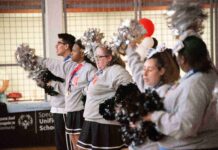In UofL’s case, the answer is Wasser, as in Lawrence Wasser, an assistant professor in pediatrics and a competitive crossword puzzle worker.
For the last two years, Wasser has created crossword puzzles for the 50 or so medical students who study at University Child Health Specialists (UCHS)-Broadway.
The puzzles are pretty much a fun exercise, he said, although I tell them not to worry as it is only 40 percent of their grade — just kidding. I usually give out a fair amount of hints — especially concerning the non-medical terms.
Such clues as target for griseofulvin and kidney tumor eponym test the students’ medical knowledge, but interspersed among them are more general knowledge clues: site of worst nuclear accident in the USA and architect of the Louve pyramid, for instance.
Some of the students may be new to crossword puzzles, but Wasser has been around the brain teasers for most of his life.
When I was little, my parents did them, and I watched, he remembered.
The crossword puzzle bug didn’t bite him, though, until college: Friends in the dorm were doing them, and I got interested in working them.
What started as a college distraction became for him a competitive challenge, a Super Bowl of words.
Wasser has competed in the American Crossword Puzzle Tournament held by New York Times’ Crossword Puzzle Editor Will Shortz for the last 11 years.
The nation’s oldest and largest crossword puzzle competition draws hundreds of participants who jot at eight original crosswords created especially for this event.
Participants are, Wasser noted, of the pocket protector crowd: retired librarians, computer programmers, musicians and so on.
The competition is rigorous: The clever clues are designed to mislead you.
Scoring is based on accuracy and speed, with prizes awarded in more than 20 categories. The grand prize is $5,000.
Wasser has placed in the top five of the southern region every year since 2002. Three of those years, he placed as high as second. Also since 2002, he has been in the top 100 overall with the total field size ranging from 412 to 727 participants.
In the classroom, Wasser lets his students work together. There’s no rigorous time limit and no misleading clues. His hobby just seemed to make sense for his teaching and helps students learn about pediatrics.
Wasser, started in practice in Louisville in 1979, and has been working full time at UCHS since 2006 after many years volunteering there. He received his MD from Johns Hopkins University in 1974 and completed his residency at Children’s Hospital Medical Center (Boston) in 1977.



























